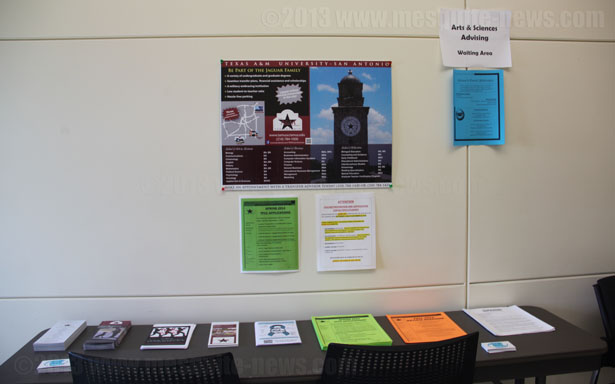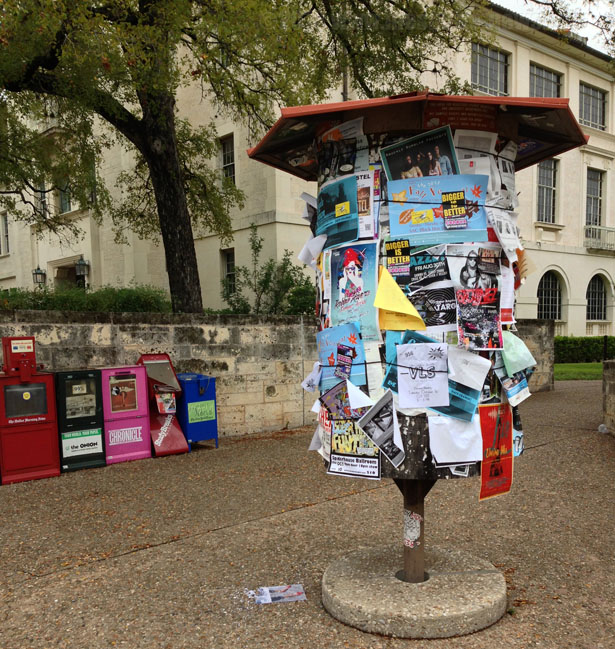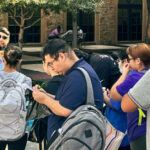
By Rebecca Salinas
In this digital age, it may seem that electronic monitors could successfully take the place of bulletin boards at a university. This has not been the case at Main Campus Building, where a lack of bulletin boards is causing frustration and limited communication options for some faculty.
Should old fashioned paper and push pins be replaced by digital fliers, or is there a happy medium between old and new? One faculty member is advocating for more bulletin boards to increase communication with her students.
English Professor Ann Bliss said this is a topic she repeatedly discussed with Dr. William Bush, humanities and social sciences chair, and Dr. Mirley Balasubramanya, dean of arts and sciences. Bliss requested bulletin boards be put outside faculty offices but said she has not received a response.
Marilu Reyna, associate vice president for university communications and institutional advancement, said the placement bulletin boards were taken into consideration to maintain the appearance of the building.
“Obviously they can get pretty messy and outdated,” she said. “They were strategic on where they placed them so that students can still see them, but yet they will not be a negative on the aesthetics of the building.”
Art installments, paid for through a tuition revenue bond, feature the work of artists Lionel and Kathy Sosa, as well as other San Antonio artists including Jesse Trevino and Joe Villareal throughout Main Campus Building. That could be one reason the university is reluctant to hang bulletin boards throughout campus.
Bush said the bulletin board issue has been around since they moved into Main Campus in fall 2011. He said, “Whether or not there has been a decision made to have them or not have them, happened at a level above me.”
He said requests have gone “up the chain” from chairs to the provost and he is unaware of any future plans.
He said faculty have requested them so they can post office hours, announcements, fliers and “whatever you would see outside faculty offices.” He added the lack of bulletin boards have been a problem with communication because faculty are not able to post things outside their office. He said faculty tape office hours and fliers on their office door, or maintain communication by email or Blackboard too.
Bliss said professors should be able to inform students about events and internships with a bulletin board outside their office.
“It does kind of remove an avenue of communication for faculty,” Bush said.
On the first floor, two bulletin boards are located by the eastern entrances and there are 12 monitors total. On the second floor, there are two bulletin boards near the restrooms, one bulletin board at the education advising waiting area and no monitors. On the third floor, there is one bulletin board near the southern restroom and no monitors.
At the start-up university, where there is currently only one completed building, reaching a happy medium to accommodate administration, faculty, staff and students can be difficult.
But is this just a problem on this campus? A recent visit to University of Texas at San Antonio gives the impression that other universities in the area have found a happy medium between digital boards and bulletin boards.
“Professors in virtually every university … have bulletin boards outside their office and they put up information about their classes, conferences or opportunities for students; and we can’t do that. We don’t even have a space to put out office hours,” Bliss said.
Hoyt Garner, student ambassador and Campus Activities Board president, said there is a small lapse in communication overall, but bulletin boards are being underutilized both ways. He added that monitors, or e-boards, are also not being looked at by students.
“I don’t see a lot of students looking at fliers or the boards. Whether they are the bulletin boards or the e-boards,” he said.
Reyna said the university uses mass emails, Blackboard, Facebook and monitors to make up for the lack in bulletin boards.
Garner said social media sites and email have been helpful for communication because he regularly checks them, but added most students do not.
“I think that is also the other issue. Students aren’t utilizing those resources, aren’t checking their Jaguar email, aren’t following the university’s Facebook or Twitter feeds,” he said. “We can put out all the information we want to students, but if those students aren’t looking at the information, they’re not reviewing the information, they aren’t going to know it.”
Vicky Elias, Faculty Senate secretary and sociology professor, who has also raised concerns, said most of the complaints about miscommunication come from faculty.
Sociology Professor Joe Simpson said it is hard to have communication in one area because the university is separated in different locations.
He said bulletin boards are a good form of communication because they disperse information for those who want it, unlike unwanted emails.
“Using bulletin boards is a traditional way of communicating information in a common, public area,” Simpson said. “It (bulletin boards) makes the communication available if you want it, and if you’re interested in it, and gives visual stimulation, that I think is missing sometimes in other forms of communication.”
Bliss said she doesn’t want to change the aesthetics of the building, but somehow information needs to be better disseminated.
Elias said university buildings do not have to be formal or informal to be effective.
“I think you can have really big, fancy buildings that include bulletin boards and student lounges,” she said.
She said bulletin boards reflect the college or department they are located. She added the ideas of all bulletin boards being messy or ruining the aesthetic of a building are not exactly true.
“They take on the personality, and that’s good,” she said. “Departments do need those spaces to exhibit their own personality.”
She said a bulletin board in the engineering department could be clean and organized, while a bulletin board in the art department could be messy and chaotic.
Elias said attending a big, “pretty” school may be intimidating, which is not necessarily a bad thing.
“The latent goal of higher education is a level of professionalization. Students are expected to learn how to conduct themselves professionally,” she said.
She said students learn how to feel comfortable in places they are unfamiliar with in college.
“Even if they feel a little bit intimidated, that may be a really important part of their education,” she said.
Bush said the building belongs to everyone involved with the university, including students, faculty, staff and administration, so there is an issue of ownership.
Simpson said it would be a bad decision to have either a formal or informal building for students. He said spaces are dedicated to certain activities, so there are spaces for offices, classrooms and students.







